
The inherent reluctance of the brain
We may let ourselves be convinced, but our brains are programmed with a bias to say “no”.
Are you one of those who prefers to take your holiday at the same place as last year and who order the same dish every time?
Now you have a study to refer to when others nag and say you ought to try something new.
“It looks like we are naturally wired to say no. We have a group of neurons called D1R which send out yes [Go] signals, and a rival group called D2R which send a No-Go command,” says Arvind Kumar, a researcher at the Royal Institute of Technology in Stockholm.
“These two groups of brain cells are projected in a pathway that makes them inhibit each other. Our research shows that the No-Go neurons exert more inhibition on the Go neurons than vice-versa,” he says.
Liquid courage
Kumar and his colleagues have used a computational model for brain research, developed from data from rodent brains. Although they found that the brain cells which say Go or yes have a tougher job than their naysaying counterparts, their relative strengths can be altered. This is what happens for instance when someone gets “liquid courage” by drinking alcohol.
“It looks as if dopamine makes the D1R neurons more active. So a higher level of dopamine makes it more probable that we will make a yes decision,” says Kumar.
Dopamine is the chemical in the brain which acts as a neurotransmitter, transferring signal from one neuron to the next. It is produced in the brain and a high level of dopamine promotes a feeling of joy and well-being. Sex, food, excitement and substances like alcohol or drugs stimulate the production of dopamine.
“We already know that the substance use can affect our decision-making processes. But our research can contribute to an explanation of how this works,” says Kumar.
Improving knowledge of brain diseases
The neurons that say No Go, D2R, normally dominate the basal ganglia. These are collections of nerve-cell bodies buried deep in both halves of the brain. The basal ganglia play a decisive role when we make decisions. Kumar explains that the Go cells only dominate when highly stimulated.
“The decision-making threshold is created by the inhibiting connection between the two groups of cells,” says Kumar.
The research was conducted in cooperation with Bernstein Center for Computational Neuroscience in Berlin and the University of Freiburg. The Royal Institute of Technology in Stockholm writes in a press release that the research sheds new light on the cognitive problems associated with basal ganglia dysfunction, such as Parkinson’s disease and Tourette’s syndrome.
“People with Parkinson’s have little dopamine, which means that their D2R cells are more active. So they are more inclined to block their choices and need very strong motivation to make a decision,” says Kumar.
----------------------------
Read this article in Norwegian at forskning.no
Translated by: Glenn Ostling









